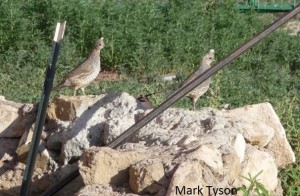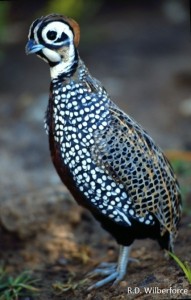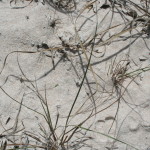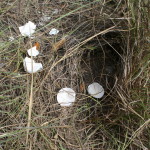Northern Bobwhite
Scientific Name: Calinus virginianus
Who’s Who?: Males are called cocks, females are called hens, and babies are called chicks. A group of quail is known as a covey (between 6-25 quail) and a clutch is a nest of eggs.
Common Name: Bobwhite
Color: Brown, black and white. Males have a white stripe along their eyes and throat while females have a brown stripe. Both display a crest on top of their heads.
Vocalizations: Northern bobwhites have distinct calls to communicate with other quail in their covey. Calls can be used to attract a mate, to sound an alarm when predators are around, or to regroup a scattered covey.
Habitat: Bare ground for food, Herbaceous (plant) cover for nesting, Woody cover (trees) for shade and protection from predators.
Diet: Seeds from plants and grasses, insects (grasshoppers, ants, termites), fruit from cacti, nuts and leaves.
Clutch:On average 12-13 eggs that are white and oval shaped, like a guitar pick. They are slightly larger than a silver dollar.
Predator: Mammalian (coyotes, racoons, skunks, snakes), Avian (hawks, northern harrier, owls).
Where can I see one?: Throughout the 10 ecoregions of Texas, with minor populations occurring in the Trans-Pecos.
Scaled Quail
Scientific Name: Callipepla squamata
Common Name: Blue or Cotton Top Quail
Color: Scaled quail are bluish-gray in color with a “scaled” feather pattern on a patch of their breast. Males have cream colored throats while females have a brownish colored throat.
Vocalizations: During the breeding season, males make a “Cree” or “Squawk” sound. The gathering call is the most frequently heard sound and is used to locate other quail, denoted by a “chip-churr, chip-churr” noise.
Habitat: They prefer a more upland habitat with scattered shrubs and open patches of ground.
Diet: Scaled quail consume insects (beetles, grasshoppers), seeds and green vegetation (leaves, grasses, succulent plants).
Clutch: Estimated around 13 eggs that are slightly larger than a bobwhite’s eggs.
Predator: Raccoons, snakes, coyotes and feral hogs are just a few of quail and quail nest predators.
Where can I see one?: This quail species occupy six eco-regions of Texas including the Trans-Pecos, Mountains and Basins, High Plains, Rolling Plains, Edwards Plateau and the South Texas Plains. They prefer a drier environment where rainfall is limited.
Gambel’s Quail
Scientific Name: Callipepla gambelii
Common Name: Gambel’s
Color: Prominent teardrop-shaped, black plume on their heads. Both male and female have grey breasts and upper parts with white-streaked, chestnut sides. Males have a black face and forehead as well.
Vocalizations: Most notable is a loud three note “ka-KAA-ka” to assemble or locate other quail. A “kow” or “whit” call is used to attract a mate.
Habitat: They prefer the desert scrublands, canyons and brushy open country.
Diet: Seeds from plants and shrubs, insects, fruit from cacti, nuts and leaves.
Clutch:Usually between 10-14 creamy colored eggs with brownish spots.
Predator: Eggs are prey to skunks, coyotes and snakes while chicks and adults are prey to hawks and bobcats.
Where can I see one?: Extremely dry parts of west Texas, but mostly in New Mexico and Arizona.
Montezuma Quail
Scientific Name: Cyrtonyx montezumae
Common Names: Mearns quail, crazy quail, harlequin quail, codorniz pinta, black quail, painted quail, fool’s quail, and Massena.
Basic terms: A group of quail is a covey; the males are known as cocks, the females are hens, and the babies are chicks. A nest contains a clutch of eggs.
Color: The males have a black and white speckled appearance with a bold black and white “mask” on their face. Females are smaller and more drab, with brown being the dominant color.
Vocalization: Montezuma quail make several noises and calls to each other, including: to confuse predators, regroup with their covey, locate other nearby quail, or simply clucking while feeding.
Habitat: Usually woody areas in mountains; must have tall grass bunches for cover.
Diet: Mostly underground tubers and bulbs, plus seeds, acorns and insects.
Covey size: Usually around 6 individuals per covey.
Clutch size: Average of 11 eggs, which are white, semi-glossy, and just over an inch long.
Predator: Raptors, coyotes, and nest predators include snakes and skunks, among others.
Where can I see one? Trans-Pecos ecoregion of Texas.
Experiments for Youth
 |
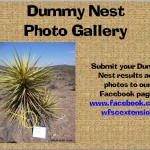 |
Submit your results to our Facebook page: WFSC Extension
Other Resources:
How Well Do You Know Quail? Take a Quiz
Make Your Own Animal Track Molds
Texas Parks and Wildlife Track Identification Guide and Quiz
Texas Wildlife Association: Quail
AgriLife Extension Youth Education Programs
Check 0ut these videos!
Citations –
Maps: Sauer, J. R., J. E. Hines, J. E. Fallon, K. L. Pardieck, D. J. Ziolkowski, Jr., and W. A. Link. 2012. The North American Breeding Bird Survey, Results and Analysis 1966 – 2011. Version 07.03.2013 USGS Patuxent Wildlife Research Center, Laurel, MD.
Dr. Dale Rollins and the Rolling Plains Quail Research Ranch, Roby, Texas.
ML Audio 105253. Montezuma Quail – Cyrtonyx montexumae. Geoffrey Keller. United State, Texas, Jeff Davis County, 4.0 km W of Fort Davis. 11 May 1993. Macaulay Library, www.macaulaylibrary.org. Cornell Lab of Ornithology.
ML Audio 45034. Scaled Quail – Callipepla squamata. Geoffrey Keller. United State, Texas, 5.0 km NW of Salineno; Falcon St. Recreational Area. 30 April 1986. Macaulay Library, www.macaulaylibrary.org. Cornell Lab of Ornithology.
ML Audio 118607. Gambel’s Quail – Callipepla gambelii. Geoffrey Keller. United State, Arizona, Organ Pipe Cactus National Monument. 12 April 2001. Macaulay Library, www.macaulaylibrary.org. Cornell Lab of Ornithology.

